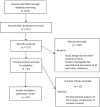Sjogren's syndrome: Review of the aetiology, Pathophysiology & Potential therapeutic interventions
- PMID: 28469828
- PMCID: PMC5410683
- DOI: 10.4317/jced.53605
Sjogren's syndrome: Review of the aetiology, Pathophysiology & Potential therapeutic interventions
Abstract
Background: Sjogren's syndrome (SS) is an autoimmune disorder characterised by lymphocytic infiltration of exocrine glands, resulting in glandular dysfunction. Objectives: This study aims to review the aetiology of Sjogren's syndrome, highlight aspects that contribute to the pathophysiology of the disease and explore treatment options that target different mediators of pathogenesis.
Material and methods: The MEDLINE/PubMed and Google Scholar databases were searched systematically with the terms "Sjogren's syndrome"; "clinical"; "treatment"; "management". Eligible studies had to meet a predefined inclusion criteria.
Results: 912 identified studies were evaluated against the inclusion criteria. 25 eligible studies were included for review. Sjogren's syndrome is a multifactorial condition with genetic, environmental and hormonal factors playing a role in establishing the condition. B-cell activating factor (BAFF) is an important mediator in the induction and perpetuation of this condition. Elevated BAFF levels, found in patients with SS, promote growth of B-cells and subsequent production of autoantibody; anti-SSA/Ro. BAFF inhibitors are important potential therapeutic drugs that may be effective in patients with Sjogren's syndrome. Other potential targets include CD20 and CD22 that cause B-cell depletion.
Conclusions: The pathophysiology of this exocrinopathy has not fully been elucidated. Potential therapeutic interventions include BAFF inhibitors and anti-CD20 and anti-CD22 therapy. However, no clinical trials have been conducted on subjects with Sjogren's syndrome to support existing research. Key words:Sjogren's syndrome, autoimmune, rheumatology.
Conflict of interest statement
Conflict of interest statement:The authors hereby report no conflicts of interest with regards to this work.
References
-
- Borchers AT, Naguwa SM, Keen CL, Gershwin ME. Immunopathogenesis of Sjogren's syndrome. Clin Rev Allergy Immunol. 2003;25:89–104. - PubMed
-
- Waterman SA, Gordon TP, Rischmueller M. Inhibitory effects of muscarinic receptor autoantibodies on parasympathetic neurotransmission in Sjogren's syndrome. Arthritis Rheum. 2000;43:1647–54. - PubMed
-
- Gaubitz M. Epidemiology of connective tissue disorders. Rheumatology (Oxford) 2006;45:iii3–4. - PubMed
-
- Harley J, Scofield R, Reichlin M. Anti-Ro in Sjogren's syndrome and systemic lupus erythematosus. Rheumatic diseases clinics of North America. 1992;18:337–58. - PubMed
-
- Shearn MA. Sjögren's syndrome in association with scleroderma. Annals of internal medicine. 1960;52:1352–62. - PubMed
Publication types
LinkOut - more resources
Full Text Sources
Other Literature Sources
Research Materials

